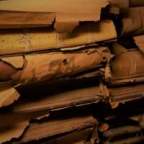×
Have a question on lubricants, wire drawing, quality, testing, ISO, environmental? Post your question here to get the answer!
Screw and barrels cleaning
- Archived Forum Admin
-
 Topic Author
Topic Author
- Offline
- Platnium Boarder
-

Less
More
12 years 7 months ago #1893
by Archived Forum Admin
Screw and barrels cleaning was created by Archived Forum Admin
Good morning
Can you please tell me if you have information about the 1", 2", 2 1/2" and 4" screw and barrels cleaning, Bronze Brushes size, materials, frequency to clean them, copper net, fabric, chemists and so on.
Thanks
Can you please tell me if you have information about the 1", 2", 2 1/2" and 4" screw and barrels cleaning, Bronze Brushes size, materials, frequency to clean them, copper net, fabric, chemists and so on.
Thanks
Please Log in to join the conversation.
- Archived Forum Admin
-
 Topic Author
Topic Author
- Offline
- Platnium Boarder
-

12 years 7 months ago #1894
by Archived Forum Admin
Replied by Archived Forum Admin on topic Re: Screw and barrels cleaning
Hello Ayala,
I am very confident that your country has many, many industrial distributors of copper wool and bronze brushes of all sizes and shapes.
It is also pretty difficult to tell you the frequency rate re the cleaning of your screws and barrels when we have no idea of the plastics or rubbers you are continuously extruding for say a week or more. We therefore recommend you contact your polymer suppliers in this regard but remember it also depends on your experience. They can also recommend the appropriate clean out compound for their polymer if you really need that information.
One old method:
(1) Remove the crosshead and lower the extruder temperatures.
(2) Use PVC to scrub the screw and barrel until pellets start coming out of the extruder.
(3) Empty the PVC from the extruder.
(4) Hydraulically pull the screw.
(5) Properly clean the screw and barrel with copper wool and bronze brushes. (The barrel is cleaned with copper wool wrapped around a cloth which is in turn wound on a steel pipe longer than the length of the barrel. This looks like the tamping/ priming pole used with old cannons. The cleaning head is say 8 to 12 inches long {20 to 30 cm} and very close to the diameter of the barrel.)
(6) Blow out the barrel with filtered, dry compressed shop air and check that it is completely clean. If not, clean again. Always wear safety glasses when using compressed air.
(7) Blow off the screw with the same compressed air supply. Make sure that it is completely clean.
( Reinstall the screw.
Reinstall the screw.
As far as small components (breaker plates, etc.) are concerned, you may wish to consider a small fluidized bed furnace. A bit of care must be taken when using these devices however to ensure that all residual chemicals are completely destroyed in the furnace or completely removed so that later on, no tooling corrosion occurs.
You can do your own research re furnace suppliers by going to the "Virtual Trade Show", logo above and under "Products", select "furnaces-fluidized bed".
Kindest regards,
Peter Stewart-Hay
Principal
Stewart-Hay Associates
www.Stewart-Hay.com
I am very confident that your country has many, many industrial distributors of copper wool and bronze brushes of all sizes and shapes.
It is also pretty difficult to tell you the frequency rate re the cleaning of your screws and barrels when we have no idea of the plastics or rubbers you are continuously extruding for say a week or more. We therefore recommend you contact your polymer suppliers in this regard but remember it also depends on your experience. They can also recommend the appropriate clean out compound for their polymer if you really need that information.
One old method:
(1) Remove the crosshead and lower the extruder temperatures.
(2) Use PVC to scrub the screw and barrel until pellets start coming out of the extruder.
(3) Empty the PVC from the extruder.
(4) Hydraulically pull the screw.
(5) Properly clean the screw and barrel with copper wool and bronze brushes. (The barrel is cleaned with copper wool wrapped around a cloth which is in turn wound on a steel pipe longer than the length of the barrel. This looks like the tamping/ priming pole used with old cannons. The cleaning head is say 8 to 12 inches long {20 to 30 cm} and very close to the diameter of the barrel.)
(6) Blow out the barrel with filtered, dry compressed shop air and check that it is completely clean. If not, clean again. Always wear safety glasses when using compressed air.
(7) Blow off the screw with the same compressed air supply. Make sure that it is completely clean.
(
As far as small components (breaker plates, etc.) are concerned, you may wish to consider a small fluidized bed furnace. A bit of care must be taken when using these devices however to ensure that all residual chemicals are completely destroyed in the furnace or completely removed so that later on, no tooling corrosion occurs.
You can do your own research re furnace suppliers by going to the "Virtual Trade Show", logo above and under "Products", select "furnaces-fluidized bed".
Kindest regards,
Peter Stewart-Hay
Principal
Stewart-Hay Associates
www.Stewart-Hay.com
Please Log in to join the conversation.
- Archived Forum Admin
-
 Topic Author
Topic Author
- Offline
- Platnium Boarder
-

12 years 7 months ago #1895
by Archived Forum Admin
Replied by Archived Forum Admin on topic Re: Screw and barrels cleaning
Thanks you very much my friend
Please Log in to join the conversation.
Moderators: Erik A Macs, Peter J Stewart-Hay
Time to create page: 0.066 seconds





 How to resolve AdBlock issue?
How to resolve AdBlock issue?